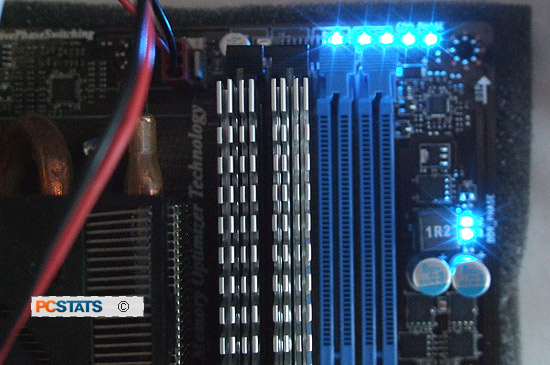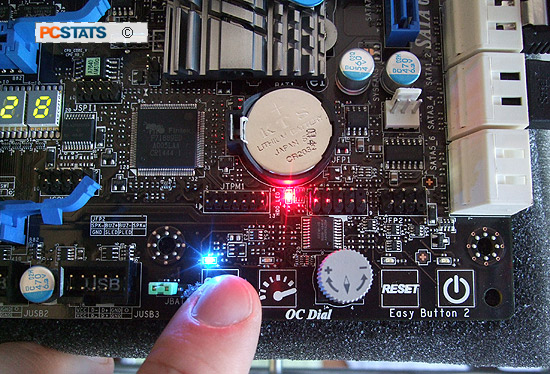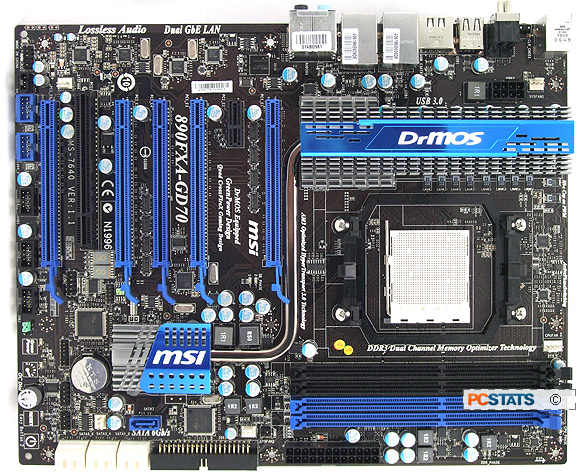 |
| Overclocking Results: |
|
|
PCSTATS
started off the MSI 890FXA-GD70 overclocking tests by dropping the multiplier on
the AMD Phenom II X6 1090T CPU from 16x to 8x, and disabling features like
Cool'n'quiet and CPU C1E power states.
A set of
DDR3-1600MHz memory modules from Corsair were installed into the MSI 890FXA-GD70
motherboard and set to run at DDR3-800 mode with the 1:2 divider.
The bus speed
of the motherboard was increased from the stock setting of 200MHz and raised
in increments of 15MHz. It was possible to hit 215MHz and 230MHz without any
issues, but speeds of 245MHz and 250MHz caused the system to crash in Windows
7 or fail to POST. A final stable bus frequency speed of 240MHz was
reached after some testing, with no voltage adjustments above the default
levels.
|

LED lights are all over the MSI
890FXA-GD70 motherboard, indicating overall system status and letting you
know at a glance if any hardware isn't connected properly.
|
A 240MHz
system bus overclock is about average for AMD chipsets, and with more voltage
tweaking it could be possible to overclock even further. As always results may
vary from system to system.
|

The system control buttons are
touch sensitive, so all you need to do is swipe them with your finger to
activate them. Just be careful around the reset and power buttons if
you're reaching into your computer while the system is still running.
|
Next up, power draw measurements and PCSTATS
test system specs... then it's on to benchmarks!
Measuring Energy
Efficiency
Energy efficient computers are a good thing, so it helps
to know how power efficient, or power hungry different parts of a computer are
when stressed with different tasks. Since it is very difficult to isolate a
videocard or CPU and measure power draw separately, PCSTATS measures total
system power draw with the aid of an Extech 380803 AC Power Analyzer and A-PFC
compliant PC Power and Cooling 750W power supply. The meter is
placed between the 120V AC outlet and the PC power supply. By stressing the test
platform's graphics solution or processor, it's then possible to measure power
draw relative to the PC at an idle state.
The test system is measured at Idle (Windows desktop),
Graphics Loaded (3Dmark06) and CPU Loaded (Prime 95) states.
|
Total System Power Draw
 MSI 890FXA-GD70 MSI 890FXA-GD70 |
|
Graphics
Solution |
Idle
|
Graphics
Loaded |
CPU
Loaded |
|
nVidia Geforce GTS250
(Discrete Graphics)
|
130w
|
276w
|
231w
|
|
(At desktop) |
(via 3Dmark 06) |
(via
Prime95) | |
The AMD 890FX chipset has a very modest TDP of only
19.6W, so even in a CPU-loaded state the total system power draw is only around
231W. When paired with a modest discrete graphics card you could even put the
MSI 890FXA-GD70 into a low-power, passively cooled system.
Prelude to
Benchmarks
The details of how the MSI 890FXA-GD70
motherboard test system was configured for benchmarking; the specific hardware,
software drivers, operating system and benchmark versions is indicated below. In
the second column are the general specs for the reference platforms this AMD
890FX based motherboard is to be compared against.

Please take a moment to look over PCSTATS test
system configurations before moving on to the individual benchmark results on
the next page.
 |
| PCSTATS Test System Configurations |
|
test system |
reference system #1 |
reference system #2 |
reference system #3 |
| processor: |
amd phenom ii x6 1090t |
amd Phenom II X4 955 Black Edition |
Intel Core i5 750 |
Intel Core i7 920 |
| CPU Process
Technology: |
45nm |
45nm |
45nm |
45nm |
| Socket: |
Socket AM3 |
Socket AM3 |
Socket LGA1156 |
Socket LGA1366 |
| Clock
Speed: |
16x 200MHz = 3.2 GHz, Turbo Core @
3.6GHz (1090T) |
16 x 200 MHz = 3.2 GHz |
20x 133MHz = 2.66 GHz |
20x 133MHz = 2.67 GHz |
| Motherboard: |
MSI 890FXA-GD70 (AMD
890FX)
Gigabyte GA890FXA-UD7 (AMD 890FX) |
Biostar TA890GXE (AMD 890GXE)
ASUS M4A89GTD-Pro
(AMD 890GX)
Gigabyte GA-MA790FXT-UD5P (AMD
790FX)
MSI 785GM-E65 (AMD 785G)
ASUS
M4A785TD-V Evo (AMD
785G
Gigabyte GA-MA785GMT-UD2H (AMD 785G)
Gigabyte GA-MA785G-UD3H (AMD
785G) |
Gigabyte GA-P55A-UD6
(P55 Express)
Gigabyte GA-P55-UD6 (P55 Express)
Gigabyte
GA-P55-UD5 (P55 Express)
Gigabyte
GA-P55A-UD4P
(P55 Express)
Gigabyte GA-P55-UD3R (P55 Express)
ASUS P7P55D-E Pro (P55
Express)
ASUS P7P55D Premium (P55 Express)
ASUS
P7P55D Deluxe (P55 Express) |
MSI Eclipse
Plus (X58 Express)
MSI X58 Platinum (X58 Express) |
| Videocard: |
ASUS ENGTS250
DK
(Geforce GTS250) |
| Memory: |
2x2GB Corsair XMS3-1600C9 DDR3 |
2x 2GB Corsair XMS3-1600C9 |
3x2GB Corsair TR3X6G1600C8D DDR3 |
| Hard Drive:
|
74GB Western Digital Raptor WD740 |
|
Optical
Drive: |
ASUS BC-1205PT-BD |
| Power
Supply: |
PC Power & Cooling TurboCool 750W |
| Heatsink: |
Athlon64 Reference
Heatsink |
Intel Reference 1156 Heatsink |
Intel Reference 1366 Heatsink |
| Operating
System: |
Microsoft Windows 7 Ultimate
(32-bit) |
| Drivers: |
Microsoft Windows 7 Ultimate
AMD Catalyst
10.3b
nVIDIA Forceware 195.62 |
Microsoft Windows 7 Ultimate
AMD Catalyst
9.12
nVIDIA Forceware 195.62 |
Microsoft Windows 7 Ultimate
Intel
9.1.1.1019
nVIDIA Forceware 190.62 |
Microsoft Windows 7 Ultimate
Intel INF
9.1.0.1012
nVIDIA Forceware 182.08 |
| Benchmarks:
|
System Benchmarks:
SYSmark
2007
PCMark Vantage
SiSoft Sandra 2009 |
Calculation B/M:
Super Pi 1.5
wPrime
2.0
ScienceMark 2.3
Bibble 5 |
Rendering B/M:
Cinebench R10
POV-Ray
3.7 |
Gaming B/M:
3DMark06
3DMark
Vantage
Cyrsis
FEAR
| | |
